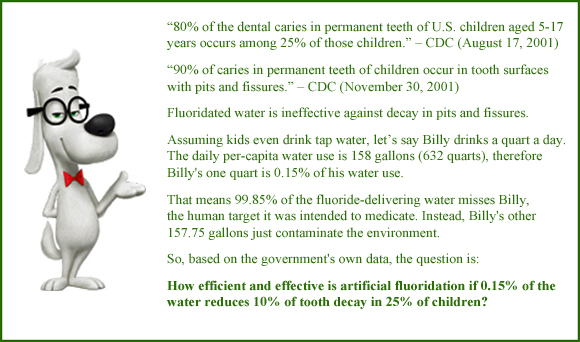|
Needs to Be Known
Know News
|
CDC Division of Oral Health's
|
|
Fluoride's "actions primarily are topical." (CDC 1999) Saliva and teeth are briefly exposed to fluoridated water while it's in the mouth. Swallowing fluoride ultimately also involves a topical action, because fluoride enters the bloodstream and into bodily tissues, including salivary glands that secrete a tiny amount of ductal fluoride to topically affect teeth. "Saliva is a major carrier of topical fluoride. The concentration of fluoride in ductal saliva, as it is secreted from salivary glands, is low – approximately 0.016 parts per million (ppm) in areas where drinking water is fluoridated and 0.006 ppm in nonfluoridated areas.[ref. #27 - below] This concentration of fluoride is not likely to affect cariogenic activity..." (CDC 2001)
But wait! It gets even more nutty:
This extra 0.2 micrograms per hour is a whopping 0.005 milligrams per day! CDC's Division of Oral Health believes that makes all the difference: inhibiting bacteria and remineralizing over a 100 tooth surfaces. Seriously? Their fluoridation 'science' is explained below.
|
Fluoridation 'Science'
Okay then, how much can "drinking fluoridated water... raise the concentration of fluoride in saliva present in the mouth" compared to "brushing with fluoride toothpaste, or using other fluoride dental products"? Reality check: essentially zero.
This fluoridation science is like saying: Each time you brush your teeth with fluoride toothpaste and rinse with fluoride mouthwash, you'll earn $1,230 dollars. Each time you drink a glass of fluoridated water, you'll earn 70 cents plus a bonus of 1.6 cents every hour. DoH! Fluoridated Water is Crappy Mouthwash
|
|
Reference #27
Note: The low fluoride group had 0.1 ppm of fluoride in their drinking water. Today, unfluoridated cities usually have higher concentrations, which would further reduce the difference in ductal saliva concentrations – making artificial fluoridation even more useless. A reason why fluoride concentrations are increasing is because fluoridated water systems contaminate the source water of neighboring communities, as is happening in Utah:
|
Fluoridated water's insignificant effect was confirmed by the government's
biggest study that found an insignificant difference in the oral health
of children in fluoridated vs. nonfluoridated communities.

In 2010, Saarland University researchers showed that the long-hypothesized "protective layer" that fluoride supposedly forms on teeth is in fact only six nanometers thick. (10,000 layers would span the width of a human hair.) Such a minuscule layer is quickly worn away by ordinary chewing, so would not shield teeth from decay. – Does fluoride really fight cavities by 'the skin of the teeth?' (American Chemical Society)
This confirms what the CDC already knew: "The prevalence of dental caries in a population is not inversely related to the concentration of fluoride in enamel, and a higher concentration of enamel fluoride is not necessarily more efficacious in preventing dental caries."
What's more, there is no evidence of any better oral health in the eight million Americans the CDC said are served by community water systems that have "sufficient naturally occurring fluoride concentrations." [CDC 2008]
|
FDA Confirms Ineffectiveness of Fluoridated Water After reviewing the best available evidence,
|
|
Safety Protocols Ignored When Fluoride Delivered Via Faucets When deciding whether a child should be made to take a daily dose of 0.25 mg of fluoride, the American Dental Association (ADA) Council on Scientific Affairs (2010 & 2014) said:
ADA also stresses the importance of "developing a personalized prevention plan":
While these protocols are rarely followed, they are obviously ignored in fluoridated cities where children should swallow uncontrolled amounts of fluoride in tap water. No longer an individual, that child is now part of a vast herd. (Did somebody say, mass medication?)
|